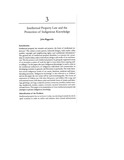| dc.contributor.author | Kiggundu, J. | |
| dc.date.accessioned | 2010-08-20T13:12:06Z | |
| dc.date.available | 2010-08-20T13:12:06Z | |
| dc.date.issued | 2007 | |
| dc.identifier.citation | Kiggundu,J. (2007) Intellectual property law and the protection of indigenous knowledge, pp. 26-47, In: Mazonde, I.N. and Thomas, P. (eds.) 2007, Indigenous knowledge systems and intellectual property in the twenty-first century: perspectives from Southern Africa, CODESRIA, Dakar | en_US |
| dc.identifier.issn | 2869781946 | |
| dc.identifier.issn | 9782869781948 | |
| dc.identifier.uri | http://hdl.handle.net/10311/583 | |
| dc.description.abstract | Copyrights may provide more effective protection for indigenous
knowledge than other forms of intellectual property such as patents, trademarks, and
97 confidential information. The most important aspect of copyright law may be neighboring rights. Neighboring rights are provided to those who perform in ceremonies or belong to groups which hold knowledge. The rights of indigenous peoples must be protected with international laws as well as national laws which are designed to protect those with indigenous knowledge. Model Licensing Agreements as well as university
involvement in indigenous knowledge are also essential for international indigenous knowledge protection. | en_US |
| dc.language.iso | en | en_US |
| dc.publisher | CODESRIA http://www.africanbookscollective.com | en_US |
| dc.subject | Intellectual property law | en_US |
| dc.subject | International law | en_US |
| dc.subject | Indigenous knowledge systems | en_US |
| dc.title | Intellectual property law and the protection of indigenous knowledge | en_US |
| dc.type | Published Article | en_US |

